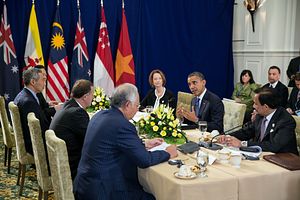The United States and 11 other Pacific Rim countries reached agreement Monday on the Trans-Pacific Partnership (TPP), a mammoth free trade pact representing nearly 40 percent of GDP, capping more than five years of negotiations.
Negotiators spent a week of talks to find consensus on key issues in the TPP, which also includes Australia, Brunei, Canada, Chile, Japan, Malaysia, Mexico, New Zealand, Peru, Singapore and Vietnam. Plans over the weekend to announce the deal were repeatedly delayed, with talks on some issues in the 29-chapter long draft deal extending into 5am Monday morning, negotiators said.
But at a Monday morning press conference past the scheduled 9am time in Atlanta, U.S. Trade Representative Michael Froman announced that the TPP countries had finally reached agreement.
“We, the trade ministers…are pleased to announce that we have successfully concluded the Trans-Pacific Partnership. After more than five years of intensive negotiations, we have to an agreement that will support jobs, drive sustainable growth, foster inclusive development and promote innovation across the Asia-Pacific region,” Froman said at the press conference, reading from the TPP ministers’ statement that was released later.
The conclusion of the TPP is a victory for the Obama administration, which has championed it as a 21st century free trade agreement and a critical part of the U.S. rebalance to the Asia-Pacific. Analysts have been warning that failure to conclude the TPP would be a severe blow to the administration’s Asia policy and a missed chance for Washington to shape the emerging rules in global trade.
The timing of the deal also hands Obama a much-needed boost just weeks before he will travel to Malaysia to meet Asia-Pacific leaders for another round of Asian summitry in November.
That being said, as I have written earlier, the finalization of the agreement is not the end of the road (See: “Finishing the TPP: It’s Not Just About the US Congress”). As Froman acknowledged at the press conference, a draft of the agreement will have to be finalized and released and each of the twelve countries will have to go through their own domestic processes before they can enter the agreement.
“We look forward to engaging with stakeholders on the specific features of this agreement and undergoing the domestic processes to put the agreement in place,” Froman said.
In the United States, the deal continues to face opposition and will need to be ratified by Congress during an election year as the clock runs down on the Obama presidency.
“Once negotiators have finalized the text of this partnership, Congress and the American people will have months to read every word before I sign it. I look forward to working with lawmakers from both parties as they consider this agreement,” Obama said in a statement following the announcement of the completion of the TPP.

































